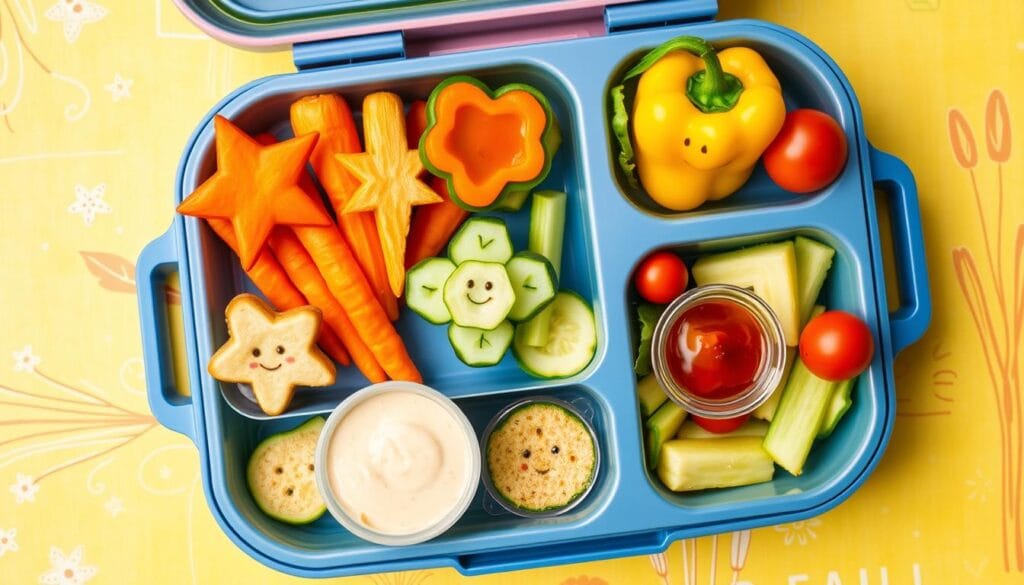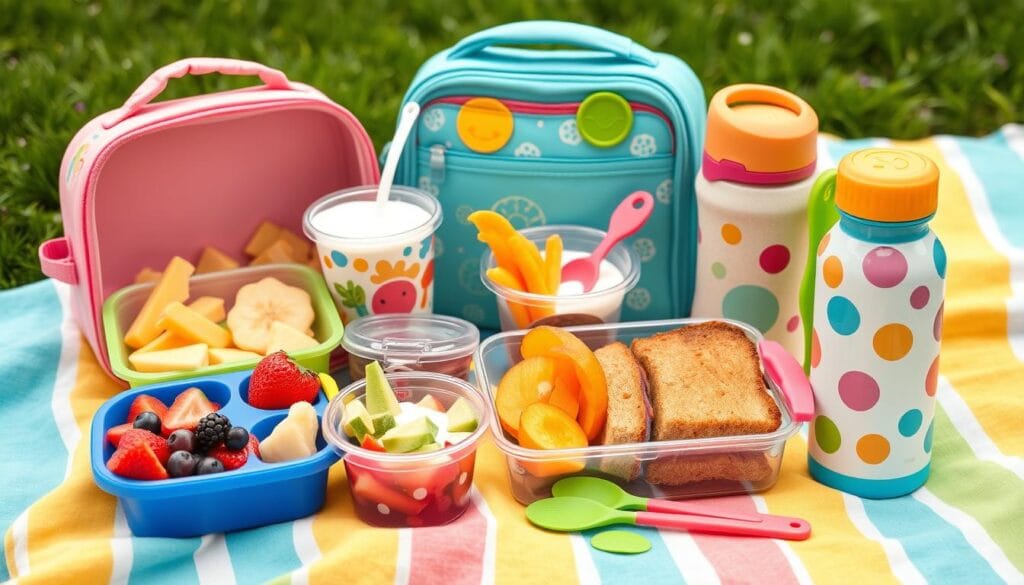Every morning, parents face the challenge of creating nutritious and exciting toddler lunch box ideas. They want to keep their little ones satisfied and nourished. It’s like solving a complex puzzle with a hungry toddler waiting.
Packing healthy toddler lunches is more than just filling a box. It’s about creating meals that spark joy and provide essential nutrients. Kid-friendly lunch box meals can turn mealtime into an exciting culinary adventure for your child.
Understanding your toddler’s preferences and nutritional needs is key. From simple sandwiches to creative pinwheel rolls, the possibilities are endless. Approach meal planning with creativity and love.
Table of Contents
Understanding Toddler Nutrition Basics
For parents, navigating toddler nutrition can be tough. It’s important to know what your child needs for healthy growth. This knowledge helps ensure they get the right nutrients.
It’s not just about filling a lunch box. Creating balanced meals is key for your child’s health. Parents often find it hard to offer a variety of nutritious foods.
Essential Nutrients for Growing Toddlers
Your toddler needs certain nutrients for growth. Here’s what they need:
- Protein: Crucial for muscle and tissue development
- Whole grains: Provides energy and essential fiber
- Fruits and vegetables: Packed with vitamins and minerals
- Healthy fats: Support brain development
“Variety is the key to ensuring your toddler receives a comprehensive range of nutrients.” – Pediatric Nutrition Expert
Portion Sizes and Balance
Knowing the right portion sizes is important. Small, frequent meals keep energy levels up and support growth.
| Age Group | Daily Calorie Needs | Meal Frequency |
|---|---|---|
| 1-2 years | 1000-1400 calories | 3 meals, 2-3 snacks |
| 2-3 years | 1200-1400 calories | 3 meals, 1-2 snacks |
Food Safety Guidelines
Keeping food safe for kids is crucial. Use insulated containers and keep perishable foods chilled. Always wash hands and surfaces before preparing meals.
- Use ice packs to maintain food temperature
- Avoid new foods in lunch boxes
- Check for potential choking hazards
- Practice proper food handling techniques
Remember, each child is unique. What works for one might not work for another, so stay flexible and observant of your toddler’s nutritional needs.
Planning the Perfect Toddler Lunch Box
Planning meals for toddlers doesn’t have to be hard. You can make a fun and healthy lunch box with a little planning and creativity. The goal is to make packing lunches easy and fun for everyone.
Here are the key things to include in a lunch box:
- Main protein source
- Fresh fruits and vegetables
- Whole grain items
- Small treat or snack
Using the right tools makes packing lunches easier. Bento-style containers with different sections help you pack meals that look good and are healthy. They also help you control portions and keep foods separate.
“Preparing lunches the night before can save precious morning minutes and reduce stress.” – Pediatric Nutrition Expert
Healthy lunches for toddlers need some planning. Here are some tips to save time:
- Batch prep ingredients on weekends
- Keep a consistent pantry inventory
- Involve your toddler in lunch planning
- Always include one familiar “safe” food
Your lunch box plan should focus on variety and nutrition. The Kid’s Healthy Eating Plate suggests filling half with colorful fruits and veggies. A quarter should be whole grains, and the last quarter should be protein.
Sandwich and Wrap Ideas for Toddlers
Creating fun and healthy toddler sandwiches can make lunchtime special. You can turn a simple lunch box into a delightful treat. It’s all about being creative and planning well.
Sandwiches are great because you can change them up to suit your toddler’s taste. They’re also packed with nutrients. About 33.3% of kids’ lunches include sandwiches, making them a favorite.
Creative Filling Combinations
Try new fillings instead of the usual peanut butter and jelly:
- Sunbutter and banana roll-ups
- Mini turkey and cheese pinwheels
- Hummus and cucumber wraps
- Cream cheese and strawberry sandwiches
Fun Shapes and Presentations
Turn simple sandwiches into fun meals. Use cookie cutters to make:
- Heart-shaped turkey sandwiches
- Star-cut cheese rolls
- Animal-shaped veggie wraps
“Eating with your eyes first” applies perfectly to toddler meals!
Allergen-Free Sandwiches
For kids with food allergies, safe and tasty sandwiches are key. Here are some ideas:
- Sunbutter and jelly on gluten-free bread
- Chickpea “no-tuna” salad wraps
- Vegetable and hummus roll-ups
With these ideas, lunchtime becomes a fun adventure. Variety is key to keeping things interesting and promoting healthy eating.
No-Heat Required Toddler Lunch Box Ideas
It’s easy to make cold lunches for toddlers. You can pack nutritious, tasty meals without much effort. These no-reheat options are great for busy parents who want their kids to eat well at school or daycare.
Creating fun no-heat lunches needs creativity and planning. Toddlers, especially those 1 to 3 years old, can be very picky. So, it’s important to offer a variety of foods to keep their meals interesting.
- Yogurt parfaits with fresh berries and crunchy granola
- Cheese and cracker plates with colorful vegetable sticks
- Mini pasta salads with protein-rich ingredients
- Pinwheel sandwiches with fun fillings
“Variety is the spice of life, especially when it comes to toddler lunches!” – Nutrition Experts
Freezing some items can keep lunch boxes cool. Frozen yogurt tubes and fruit can be natural ice packs. They also offer nutritional benefits.
| Lunch Category | Best No-Heat Options | Nutritional Benefits |
|---|---|---|
| Proteins | Hard-boiled eggs, cold chicken strips | Muscle development, energy |
| Fruits | Apple slices, berries, grapes | Vitamins, hydration |
| Snacks | Cheese cubes, crackers | Calcium, complex carbohydrates |
Make sure to pack small portions that are easy for toddlers to handle. Change up the ingredients to keep meals fun. This encourages your toddler to try new foods.
Protein-Rich Options for Growing Bodies
Protein is key for your toddler’s growth. It helps with muscle growth, brain function, and health. Knowing good protein sources is important for healthy meals.
Your child’s protein needs change with age and activity. Choosing many protein sources is best for their health.
Plant-Based Protein Choices
- Hummus with veggie sticks
- Edamame beans
- Nut butter spreads
- Tofu cubes
- Lentil-based dips
Animal Protein Solutions
For families okay with animal proteins, there are tasty options:
- Hard-boiled eggs
- Grilled chicken strips
- Lean deli meats
- Shredded turkey
Dairy Options for Kids
| Dairy Product | Protein Content | Benefits |
|---|---|---|
| Greek Yogurt | 15-20g per cup | Calcium, probiotics |
| Cottage Cheese | 12-15g per half-cup | Low-fat, versatile |
| Cheese Sticks | 6-8g per stick | Portable, kid-friendly |
“Protein is essential for every cell in a child’s body, playing a crucial role in growth and development.” – Pediatric Nutrition Expert
Change up protein sources to keep meals fun and full of nutrients. Talking to a pediatric nutritionist can guide you in choosing the best proteins for your toddler.
Fruits and Vegetables Made Fun

Making lunch boxes fun and healthy for toddlers is a fun challenge. It starts with making fruits and veggies appealing. Kids are more likely to try new foods if they look and taste good.
Here are some ways to make veggies exciting for lunch:
- Cut veggies into fun shapes with cookie cutters
- Offer colorful dips to make veggies more fun
- Make colorful vegetable kebabs
- Use muffin liners to keep veggies separate
“It may take up to 15 exposures for a child to be willing to try a new food” – Pediatric Nutrition Research
For fruit in toddler lunches, try these healthy options:
| Fruit | Preparation Tip | Nutrition Boost |
|---|---|---|
| Blueberries | Pack whole or in small containers | High in antioxidants |
| Apple Slices | Toss with lemon juice to prevent browning | Rich in fiber |
| Strawberries | Slice and pack with ice pack | Vitamin C powerhouse |
Pro tip: Let your toddler help pick and prepare fruits and veggies. This can make them more excited to eat them.
Remember, it takes time and effort. Kids might need to try new foods many times before they like them. Keep offering a variety of colorful, fresh produce. Celebrate every small success in their eating journey.
Make-Ahead Lunch Box Solutions
Getting ready for your toddler’s lunch can be easy and stress-free. Make-ahead lunches are a big help for busy parents. They save time and make packing lunches less stressful.
It’s not hard to make your toddler’s lunch prep simple. With a little planning and some smart tips, you can make tasty, healthy meals. These meals will make your toddler look forward to lunchtime.
Batch Cooking Tips
Batch cooking is a great way to make meal prep easier. Here are some tips:
- Make big batches of freezer-friendly items on weekends
- Cook proteins like chicken or beans in bulk
- Pre-chop veggies and fruits for quick meals
- Make extra portions of your favorite recipes
Storage and Organization
Storing food properly is key for keeping lunches fresh and safe. Use good, divided containers to keep foods separate and fresh.
| Container Type | Best For | Storage Tips |
|---|---|---|
| Glass containers | Hot foods | Use airtight lids, refrigerate right away |
| Bento boxes | Varied meals | Separate parts prevent mixing |
| Silicone bags | Snacks | Reusable and easy to clean |
Weekly Meal Planning
“Preparation is the key to stress-free meal packing” – Parenting Nutrition Expert
Plan your meals for the week with a mix of proteins, veggies, and grains. This ensures your child gets a variety of nutrients and makes packing lunches easier.
- Make a meal plan every Sunday
- Prep ingredients ahead of time
- Label containers with dates
- Store prepared items wisely
By using these make-ahead lunch box solutions, you can make mornings easier. You’ll also give your toddler healthy, fun meals.
Picky Eater Strategies and Solutions
Dealing with picky toddler lunches can be tough for parents. It’s important to understand your child’s food likes and encourage them to try new things. Picky eating is normal for toddlers, but there are ways to make meals fun and healthy.
Here are some creative ways to overcome food aversions and make lunch exciting:
- Use cookie cutters to transform ordinary foods into fun shapes
- Involve your toddler in lunch planning and preparation
- Offer deconstructed meals that allow kids to assemble their own plates
- Create colorful and visually appealing lunch presentations
“Patience is key when introducing new foods to toddlers. It can take multiple exposures before a child accepts a new item.”
It’s vital to know what your toddler likes to eat. Try to mix familiar foods with new ones in their lunch box. Studies show that changing up lunch ideas weekly keeps meals fun and nutritious.
| Picky Eater Strategy | Implementation Tips |
|---|---|
| Food Presentation | Use fun shapes, bright colors, and creative arrangements |
| Gradual Introduction | Introduce new foods alongside familiar items |
| Texture Variety | Offer different textures to keep meals interesting |
Every child is different. What works for one might not work for another. Stay positive, keep trying new things, and don’t get discouraged if it takes time. Encouraging your child to try new foods is a journey that needs patience and creativity.
Essential Lunch Box Gear and Equipment
Getting the right toddler lunch boxes is key. You need smart food storage and the right lunch packing supplies. The right gear makes packing lunches easy and keeps your child’s food fresh and tasty.

Quality lunch containers make meal prep fun and easy. They keep food organized, at the right temperature, and appealing to kids.
Best Containers and Packaging
Here are some top picks for lunch boxes:
- PlanetBox Rover Stainless Steel Lunch Box: Great for elementary kids
- LunchBots Quad: Ideal for babies and toddlers with its multiple compartments
- Bentgo Bento Box: Leakproof with a removable tray insert
- EasyLunchboxes: A budget-friendly option with multiple sections
Temperature Control Solutions
Keeping food at the right temperature is important. Here are some insulated options:
| Product | Temperature Retention | Price Range |
|---|---|---|
| Mira Food Jar Thermos | Keeps hot foods warm for 5 hours | $20-$30 |
| OmieBox Bento Box | Insulated for hot and cold foods | $40-$50 |
| LunchBots 8-Ounce Thermos | Good for occasional hot lunches | $20-$30 |
Time-Saving Tools
Make packing lunches easier with these tools:
- Stasher Reusable Silicone Food Bags
- Kids Stainless Steel Cutlery Set
- Silicone muffin liners for portioning
- Grape and apple slicers
Smart lunch box gear makes meal prep fun and efficient.
Tip: Pick containers that grow with your child and make packing lunches easy.
Quick and Easy Assembly Methods
Setting up a smooth lunch packing system can make your mornings less stressful. Start with smart preparation and organization. Your aim is to create a quick and stress-free lunch packing plan.
Make a special lunch packing area in your kitchen. It should have all the things you need. This spot will be your go-to for making easy meals for toddlers.
Essential Lunch Packing Tools
- Cutting board
- Sharp knife
- Measuring containers
- Pre-portioned storage containers
- Insulated lunch bag
Use a simple lunch formula to make mornings easier:
- Protein source – Chicken, eggs, or beans
- Fresh fruit – Sliced apples or berries
- Vegetable – Carrot sticks or cucumber rounds
- Dairy or alternative – Cheese stick or yogurt
- Small treat – Homemade muffin or granola bite
Pro tip: Prepare ingredients the night before to make morning lunch assembly a breeze!
Make a weekly lunch prep chart to mix up meals. This keeps things interesting and helps you stay organized. It’s a key part of your efficient lunch packing strategy.
Refrigerator Lunch Prep Station
Choose a spot in your fridge for pre-portioned lunch items. Use clear containers for cut veggies, proteins, and other ready-to-go foods. This makes making easy toddler meals fast and simple.
School-Safe and Allergy-Conscious Options
It can be tough for parents to follow school lunch rules for kids with food allergies. Making nut-free lunches needs careful planning and creativity. This way, your toddler stays safe and gets the nutrients they need.
“Safety starts with awareness and smart food choices” – Allergy Experts
Here are some important tips for making allergy-friendly meals for toddlers:
- Replace common allergens like peanut butter with sunflower seed butter
- Choose protein sources such as chicken, turkey, or beans
- Read labels carefully for potential allergen cross-contamination
- Use allergy alert stickers on lunch boxes
Protein alternatives can make nut-free lunches fun and healthy. Sunflower seed butter has similar protein and healthy fats to nut spreads. Lean meats, beans, and eggs are great protein sources that keep your toddler full.
Schools are getting better at food safety. Talk to teachers about your child’s food needs. Many schools have special plans for handling food allergies.
- Pack clearly labeled containers
- Include ingredient lists
- Discuss emergency procedures with school staff
By carefully making allergy-conscious meals, you can make sure your toddler has a safe and tasty lunch every day.
Conclusion
Preparing healthy lunches for toddlers is an art. It mixes creativity, nutrition, and knowing what your child likes. You don’t need to make it hard. Start with meals that are balanced and fun for your little one.
Every child is unique, so be flexible. Try different foods, textures, and ways to present them. If something doesn’t work at first, don’t worry. Keep trying new things to help your child try new foods.
Your goal is to make meals that are good for your child’s body and mind. Use fun shapes and stay positive. This way, making lunch becomes a chance to bond and grow together. Your hard work will help your child grow and make mealtime special.
Be patient and creative when making healthy lunches for toddlers. Your hard work will feed your child’s body and spark their interest in food. With time and effort, you’ll get better at packing lunches.

